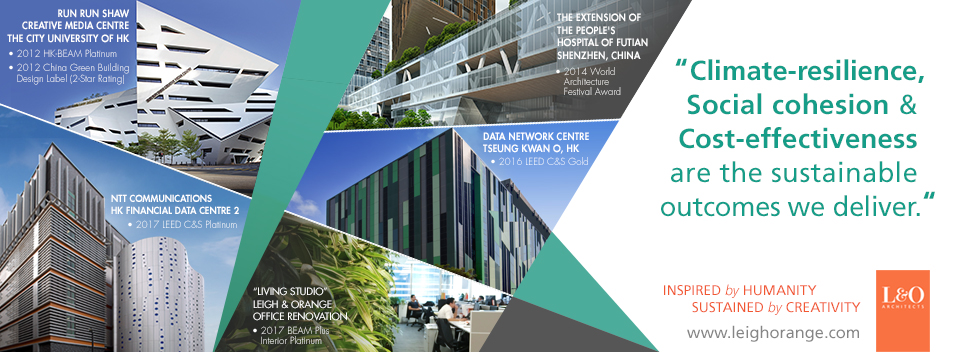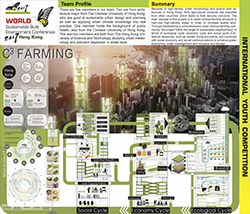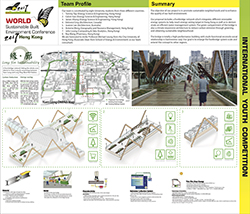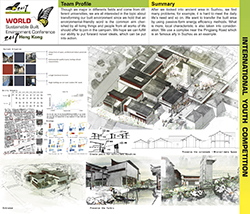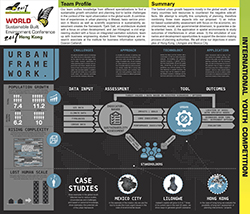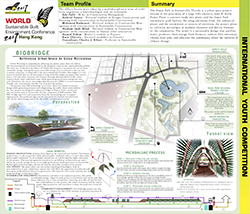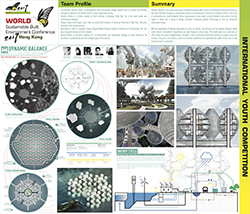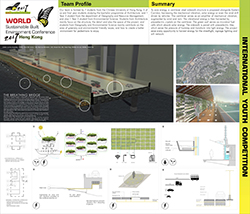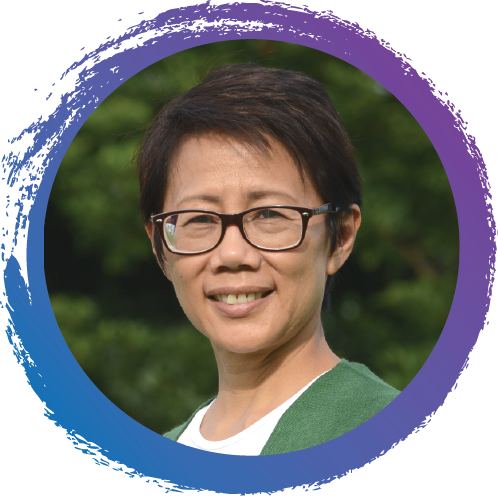
A. Introduction
WSBE17 Hong Kong - International Youth Competition invites imaginative ideas, projects and action plans that best demonstrate an innovative interpretation of the Conference theme “Transforming Our Built Environment through Innovation and Integration: Putting Ideas into Action” and the key discussion areas:

WSBE17 Hong Kong is the best platform to be seen and to be recognised! All shortlisted teams will:
-
Display their brilliant ideas at WSBE17 Hong Kong
-
Be known to over 1,800 global industry experts
-
Present in front of a panel of internationally acclaimed judges
-
Win a cash prize of HK$10,000 and 2 Conference Tickets
B. Eligibility
Age:
30 or below
Team Formation Criteria:
-
At least 2 full-time tertiary students who study in sustainable built environment-related disciplines, e.g. Architecture/ Engineering/ Green Building Studies/ Building Technology/ Urban Planning and Design/ Landscape/ Surveying, etc., AND
-
At least 2 team members from other subjects such as natural sciences, social sciences, economics, medicine, etc.
-
All members must be identified in the online registration form. A team leader must be designated. S/he is the team’s sole representative to complete the registration online and liaise with the Competition Organiser.
-
All members in the team are regarded as co-authors of the submission. They will be acknowledged as such in all announcements, displays, exhibitions and other materials related to the competition, in the order in which their details are listed in the registration form.
C. Shortlisted Teams
We are thrilled to receive around 100 entries from 25 countries from all over the world. After multiple rounds of judging and deliberation, the following 8 entries have been shortlisted:
D. Honourable Mention
E. Jury
 |
Prof. Thomas AUER Managing Director, Transsolar Thomas is partner and managing director of Transsolar, an engineering firm with offices in Stuttgart, Munich, Paris and New York. He collaborated with world known architecture firms on numerous international design projects. He is a specialist in energy efficiency and environmental quality. Thomas has developed concepts for buildings and districts around the world noted for their innovative strategies. Thomas taught at various universities around the world. Since 2014 he is full Professor at the TU of Munich with a focus in bridging academia and environmental design. |
|
|
Dr George BAIRD Emeritus Professor, Building Science, School of Architecture, Victoria University of Wellington Dr George BAIRD, FCIBSE, FIPENZ, is Emeritus Professor of Building Science at the School of Architecture, Victoria University of Wellington.A Scot by birth, he gained his PhD in Engineering from Glasgow University and attended the National College for HVR&F Engineering in London. Following six years at the Building Services Research Unit, Glasgow and six at the Architecture School, Aberdeen, he moved to New Zealand in 1975 to help set up the School in Wellington. There, he has specialised in building environmental science and sustainable engineering systems design, building performance generally, and the energy efficient design and operation of buildings. For current details see http://www.victoria.ac.nz/architecture/staff/george-baird.aspx |
|
|
Prof. Greg FOLIENTE Enterprise Professor, University of Melbourne Prof. Greg FOLIENTE is Enterprise Professor in Sustainable and Resilient Built Environment at the University of Melbourne, the Founding Director of the international consulting practice nBLue Pty Ltd, and the Asia-Pacific Director of the International Initiative for a Sustainable Built Environment (iiSBE). He is also currently a Guest Professor in the EU-based International Master’s and PhD Programme in Sustainable Built Environment. For over twenty years, he was Senior Science Leader at CSIRO, Australia’s national science agency. He has led a number of successful national and international interdisciplinary research programs, represented Australia in a number of official government “missions”, and served as an expert consultant to United Nations agencies (UNEP and UNFCCC), and the Asian Development Bank and the World Bank. |
|
|
Prof. Peter GUTHRIE Professor, Engineering for Sustainable Development, University of Cambridge Peter GUTHRIE was appointed in 2000 as the first Professor in Engineering for Sustainable Development in the UK. His research is focused on the assessment of large scale projects for sustainability, resilience in infrastructure, energy efficiency in buildings, and sustainability in developing countries. He has experience of research in the sustainable development of infrastructure in developing countries, including the challenging of the appropriateness of technical standards, issues of waste management, provision of basic services in rural contexts, and the potential for waste materials to be used as materials in construction, and the engineering of earth roads. He has worked with FIDIC (Federation of International Consulting Engineers) to produce a report on sustainability assessment for infrastructure (http://fidic.org/books/state-world-report-2012-sustainable-infrastructure). |
|
|
Ms Deborah KUH Head of Greening, Landscape and Tree Management Section, The Government of the Hong Kong Special Administrative Region Ms. Deborah KUH is an internationally recognised designer, specialising in inter- and trans-disciplinary urban design, master planning, architecture, landscape architecture, interpretation and furniture design projects. She bases her designs on the concept of Place Ecology, focusing on sustainability, connectivity, tactility and respect for diversity of the human condition. Her work spans geographies including Australia and the Middle East. Ms. KUH returned from Australia in 2015 to join the Hong Kong government's Development Bureau where she explores policy opportunities, such as landscape resilience and adaptation, urban forestry and biodiversity in the city, with the aim of promoting a more liveable city. |
|
|
Ms Christine LOH Under Secretary for the Environment, The Government of the Hong Kong Special Administrative Region Ms Christine LOH was the Chief Executive Officer of the non-profit public policy think tank Civic Exchange prior to joining the HKSAR Government in September 2012. Prior to founding Civic Exchange in 2000, Ms LOH had spent nearly a decade as a politician and member of the Legislative Council (1992-97 and 1998-2000). |
|
|
Prof. Serge SALAT President, Urban Morphology & Complex Systems Institute Serge SALAT is an urban planner, a scientist in the science of complexity, an art historian and an internationally recognized architect/artist. He is the founder and President of the Urban Morphology and Complex Systems Institute based in Paris. Serge SALAT has been seminal in applying the science of complexity to cities. He has authored more than 20 books on art and architecture, as well as more than one hundred publications and communications. He has opened the way in introducing physics far away from the equilibrium, fractals, as well as network analysis and complexity science to a better understanding of cities. He is a practicing architect and city planner and advises international organizations such as United Nations, The World Bank, AFD (French Agency for Development) and CDC (Caisse des Dépôts et Consignations), on strategic transitions of urbanization in particular in China, where he brings a unique integration of scientific skills, economic, financial and governance competence with his experience of designer of large scale projects to advise on national policies as well as on specific projects. He is one of the authors of the Fifth IPCC assessment report. |
|
|
Prof. Arno SCHLUETER Professor, Architecture and Building Systems ETH Zurich Arno SCHLUETER holds a degree (Dipl.Ing.) in Architecture from the Technical University of Karlsruhe, a postgraduate degree in computational design and a PhD in building systems from ETH Zurich. In 2010, he was appointed Assistant Professor and in 2014 Professor of Architecture and Building Systems (A/S) at the Institute of Technology in Architecture (ITA), ETH Zurich. Since 2013, he is also Principal Investigator at the Singapore-ETH Future Cities Lab (FCL). In his research, he focuses on the integration of energy and indoor environmental systems into buildings and districts using computational approaches and physical prototypes. In 2009, he co-founded the design and engineering office KEOTO.ch, where he is part of the management board. |
F. Submission Requirements
Presentation panel:
1 panel in A1 size laid out in landscape format must be digitally submitted in one single file.
The template can be downloaded here.
The panel should include a brief profile of all team members with a 100-word executive summary in English. The summary should describe the key concepts and features relevant to the competition theme and requirements.
File Format and size:
The file must be saved as high resolution PDF capable of being conveniently viewed on a computer screen as well as to be printed out to A1 size for exhibition (300 dpi).
The file must be named under the following logic: WSBE17 Hong Kong_IYC_Entry ID.
Please submit the registration and presentation panel through the online system on or before 21 Dec 2016.
Content:
The content should be sufficient to convey a clear understanding of the Conference theme. The panel could consist of drawings, rendered images, photographs, thumbnails, text or anything entrants find suitable to illustrate their ideas.
Copyright:
All work submitted must be the applicant’s original work. It is the applicant’s sole responsibility to ensure that the work submitted does not infringe upon the intellectual property rights of any third party, including, but not limited to, copyright, trademark and design rights.
G. Prizes
The jury will perform first round judging to select no more than 10 teams with reasons provided. Shortlisted teams must send at least 1 representative to make a presentation on their proposal during the WSBE17 Hong Kong (5-7 Jun 2017) during final judging. After the presentation, the jury will grant a special award to each team.
All shortlisted teams will:
-
Display their entry in WSBE17 Hong Kong Exhibition
-
Present in front of a panel of internationally acclaimed judges
-
Special award presented by the jury
-
Cash prize of HK$10,000 and 2 Conference Tickets
Remarks:
- Prizes will be presented to shortlisted teams under the condition that the team can send at least 1 representative to attend the Conference and make a presentation during final judging.
- Prizes will be presented to the team representative and are to be shared at the discretion of the team members.
- The jury’s decision shall be final and binding on all entries.
- The Competition Organiser reserves the right to use the entries and photos for marketing purposes.
- The Competition Organiser reserves the rights to change the rules of the Competition.
H. Competition Timetable
Deadline for submission: 21 Dec 2016
Announcement of shortlisted teams: End of Feb 2017
Presentation of shortlisted teams to the jury, Prize Presentation, Exhibition of shortlisted entries: 5-7 Jun 2017 (Incorporated in the Conference Programme, exact date to be announced)
For any enquiries please contact WSBE17 Hong Kong Secretariat: +852 3468 7175 / competition@wsbe17hongkong.hk
